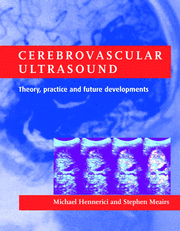Book contents
- Frontmatter
- Dedication
- Contents
- List of contributors
- Preface
- PART I ULTRASOUND PHYSICS, TECHNOLOGY AND HEMODYNAMICS
- 1 Introduction to Doppler ultrasound
- 2 Doppler technology
- 3 Principles and models of hemodynamics
- 4 Computational principles and models of hemodynamics
- 5 Flow patterns and arterial wall dynamics
- 6 Duplex and colour flow imaging
- 7 Misconceptions and artefacts in ultrasound examination of the carotid arteries
- PART II CLINICAL CEREBROVASCULAR ULTRASOUND
- PART III NEW AND FUTURE DEVELOPMENTS
- Index
4 - Computational principles and models of hemodynamics
from PART I - ULTRASOUND PHYSICS, TECHNOLOGY AND HEMODYNAMICS
Published online by Cambridge University Press: 05 July 2014
- Frontmatter
- Dedication
- Contents
- List of contributors
- Preface
- PART I ULTRASOUND PHYSICS, TECHNOLOGY AND HEMODYNAMICS
- 1 Introduction to Doppler ultrasound
- 2 Doppler technology
- 3 Principles and models of hemodynamics
- 4 Computational principles and models of hemodynamics
- 5 Flow patterns and arterial wall dynamics
- 6 Duplex and colour flow imaging
- 7 Misconceptions and artefacts in ultrasound examination of the carotid arteries
- PART II CLINICAL CEREBROVASCULAR ULTRASOUND
- PART III NEW AND FUTURE DEVELOPMENTS
- Index
Summary
Introduction
Quantitative hemodynamic considerations are important for an increased understanding of blood vessel pathology and for the development of blood vessel prostheses. The hemodynamic factors of primary interest are blood pressure and blood flow rate. Furthermore, flow-rated quantities as wall shear stress and local blood particle residence time are also a matter of great interest. While blood pressure could have been reliably measured clinically for many years, accurate blood velocity measurements including certain disturbances as local flow separation, recirculation and stagnation have been developed during the past two decades. Modern non-invasive methods for quantitative evaluations of arterial flow patterns are based on computer assisted applications of ultrasound (Hatle & Angelsen, 1985; Reneman et al., 1985; Steinke & Hennerici, 1989; Van Merode et al., 1989) and magnetic resonance imaging (Boesiger et al., 1992, Botnar et al., 1996; Nayler et al., 1986).
Today, these non-invasive measuring procedures are used to determine blood flow velocity at the routine clinical level. This holds especially for the ultrasound Doppler anemometer. The application in clinical practice of the measurements brought greatest success in the early diagnosis of cardiovascular diseases, as well as objective evaluations of corresponding therapeutic actions.
An alternative approach to determine arterial flow parameters uses mathematical modelling and computer simulation of the processes. The numerical simulation of arterial hemodynamics offers a non-invasive method for obtaining detailed and realistic measurements of normal and diseased conditions of flow without interfering with the flow.
- Type
- Chapter
- Information
- Cerebrovascular UltrasoundTheory, Practice and Future Developments, pp. 63 - 76Publisher: Cambridge University PressPrint publication year: 2001
- 4
- Cited by



